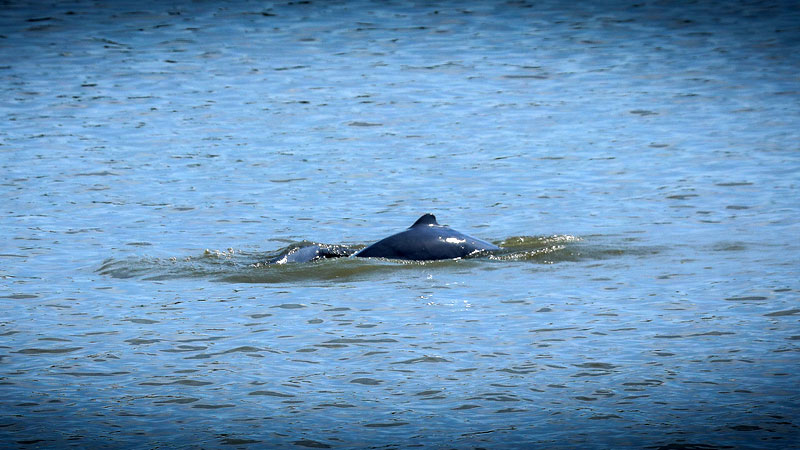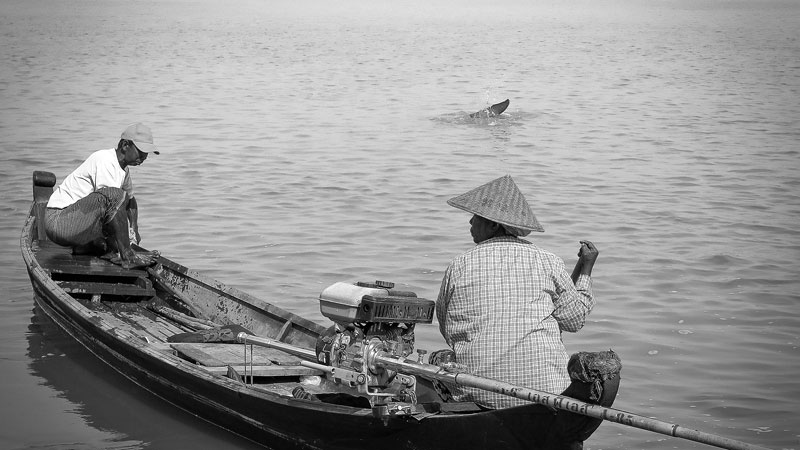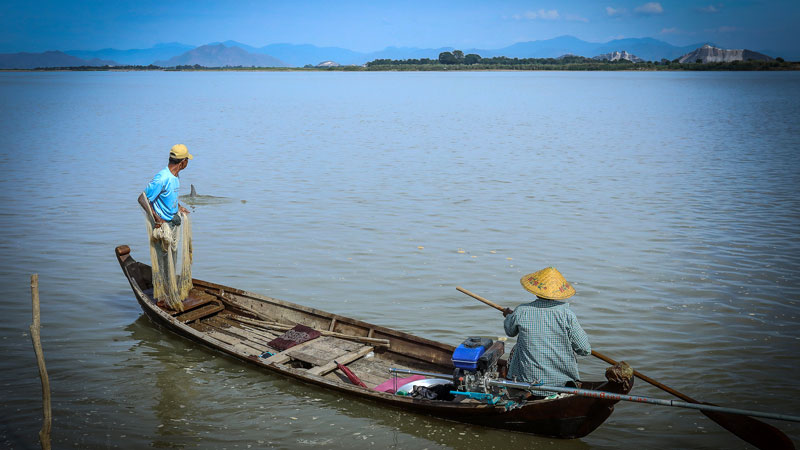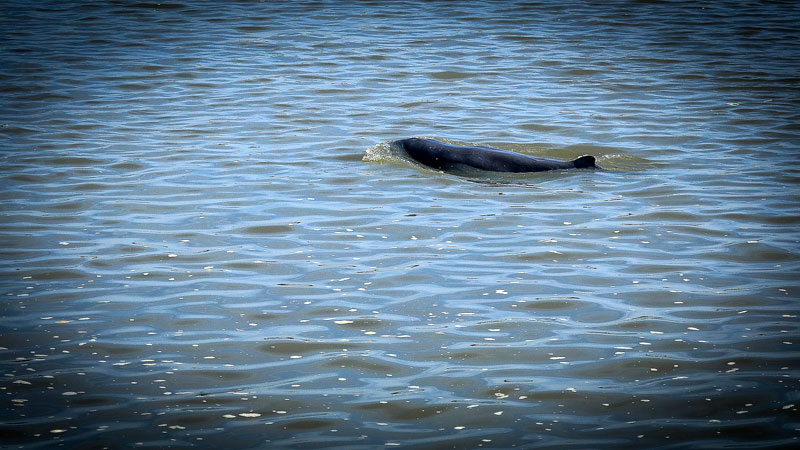Irrawaddy River
The Irrawaddy Dolphin Protected Area (ADPA) was established in 2005 and spans 74kms of the Irrawaddy River from Mingun, near Mandalay, north to Kyauk Myaung. This encompasses the habitat where the critically endangered Irrawaddy Dolphin is found.
The upper Irrawaddy River also has important bird life that includes 126 species, two of which are endangered and four are near-threatened species. These are the Green Peafowl, Black-bellied Tern, Black-headed Ibis, Oriental Darter, River Tern, Feruginous Pochard, Common Shelduck and Streak-earned Bulbul. Other notable species on the upper Irrawaddy are the Pained Stork and Greater Cormorant.
The dolphin population of the Irrawaddy River is low, but fairly stable in recent years, with annual counts between 2010 and 2017 estimated at between 60 and 70 individuals. In the past, one of the major threats came from electric fishing, which caused electrocution of dolphins and fish life.
Sedimentation in deep pools from gold mining and other dredging operations was contributing to the demise of dolphin habitat. Regulations have now reduced discharge and new safe practices are restoring the ecosystems. The conditions and protection projects are now managed by the Department of Fisheries with support by Wildlife Conservation Society with the main objective to reduce threats to dolphins through monitoring, law enforcement, education and livelihoods.
The projects conduct regular monitoring and patrol trips through the ADPA. Stakeholder meetings are held in communities, and with concerned government authorities, to coordinate the reduction of threats. An annual dolphin count survey is conducted to monitor the total population. Regular educational activities are conducted with schools and people living in the region. The projects are also assisting cooperative fishing communities to develop community-based eco-tourism in order to promote direct incentives for dolphin conservation and provide support for the symbiotic relationship between cooperative fishermen and the dolphins.
Biodiversity in Myanmar
Biodiversity refers to the variety of life. It is seen in the number of species in an ecosystem and is used as a measure of the health of biological systems.
Myanmar’s wildlife include a range of species from north, south and southeast Asia, which find shelter in a wide range of habitats throughout the country. Snow-capped and remote Himalayan Mountains lie to the North and serve as the source for Myanmar’s mainstream rivers. The rivers flow through wide, central plains and down to mangrove-lined river deltas before flowing into the Bay of Bengal. Along the country’s southern tip, the coastal waters abound with coral reefs amidst more than 800 islands of the Mergui archipelago.
A wide diversity of ecosystems is represented in Myanmar, including mixed wet evergreen, dry evergreen, deciduous, and montane-forests. There are also patches of shrub-lands and woodlands on karst limestone outcrops and, in some coastal areas, scattered heath forests. In addition, a wide variety of distinctive localized vegetation formations occur, including lowland floodplain swamps, mangroves and seasonally inundated grasslands.
Myanmar boasts 15 biodiversity corridors. These play a key role in maintaining landscape connectivity between key biodiversity areas, therefore preserving ecological processes and safeguarding against the potential impacts of climate change.
Myanmar supports one of the most diverse, yet challenged animal species in Southeast Asia. At least 27 species of freshwater turtles and tortoises are known to live in Myanmar, including eight endemic forms. Despite such high levels of diversity, turtle populations face severe threats from commercial and subsistence harvesting and some habitat destruction.
Myanmar has 49 globally threatened mammal species as well as 16 near-threatened species. There are also 26 ‘data deficient’ mammal species. Of these, the Asian Rhinoceros have almost become extinct in the wild and other species like Asian elephants, Tigers and Snub-Nosed Monkeys are threatened with near extinction.
Endangered Animals & Newly Discovered Species;
In 1997 the diminutive Leaf Muntjac, which is the smallest member of the deer family was discovered and the Forest Ministry established a national park around Hkakabo Razi.
Hukawng Valley Wildlife Sanctuary (near India in northwest Myanmar) is one of the remotest places in Myanmar and habitat to some the last largest concentrations of wildlife in Southeast Asia. Located between the Samgpang and Kumon mountains, this remote area is home to only a handful of ethic tribal minorities. Much of the travel in the area is done on foot or by boat on the Tanai and Turung Rivers. Tanai is the largest town in the region.
Among the animals found in this Northern region are Tigers, Clouded Leopard, Golden Cat, Asiatic Black Bear, Elephants, Macaques, Gibbons, Great Hornbills, Green Peafowl, Barking Deer and Samar Deer.
The three ethnic groups that inhabit the region are the Kachin, who live in the lowlands, and the Naga and Lisu, who live in the highlands.
Hukawang Valley Wildlife Sanctuary was established in April 2001. It covers about 2,500sqms. Hunting is now banned. There are plans to add 5,500 square miles to the sanctuary, making it the largest Tiger refuge in the world.
Animals such as Tigers and Leopard were hunted for the Chinese medicine market. The major focus of conservation projects is not to get people to stop hunting for food, but to get them stop hunting for profit.
White Elephants
Amongst the neighboring Thai people and other peoples of Southeast Asia, White elephants are regarded as symbols of power and fertility. According to Buddhist teachings the Buddha’s mother Queen Mahamaya dreamed of a White baby elephant at the conception of Lord Buddha. The discovery of White elephants in the wild is a major event that causes a much excitement in throughout Southeast Asia cultures.
White elephants are regarded as the most auspicious of all animals in Laos, Thailand, Burma and Cambodia. Kings added possession of them to their titles. Great empires have gone to war over them. The royal White elephants in Thailand are actually Pinky-brown, with some White markings. They are often difficult to distinguish from normal elephants. Their proper name is changsamkan, meaning ‘important’ or ‘significant’ elephant. Most are not albinos, which are usually Whitish-beige.
In August 2010, Myanmar's ruling junta threw a lavish welcome ceremony for a rare white elephant, a traditional symbol of power and prosperity, which was transported from the jungle to the country's remote capital. The 38-year-old female elephant was recently captured in the jungles of North-west Myanmar and transported by boat and truck to Naypyitaw, where it was given the name Bhaddavati, or "One Who is Endowed with Goodness," in a formal naming ceremony.
Top military leaders greeted the 7-foot, 4-inch (2.2-meter) elephant when it arrived in Naypyitaw and sprinkled the elephant with scented water during a ceremony at the Uppatasanti Pagoda, a replica of the famed Shwedagon Pagoda in Yangon, the former capital and biggest city in Myanmar. The White elephant marched in a parade of other elephants and circled the pagoda, where religious sermons were delivered for its safety and well-being. The White elephant will be housed in an enclosure at the foot of the temple.
Bhaddavati is the fourth White elephant captured and held in captivity in Myanmar in recent years. The other three are kept at a special park in Yangon, where they live in an enclosure with spiraled pavilions, a manmade waterfall, ponds and trees. White elephants, actually albinos, have for centuries been revered in Myanmar, Thailand, Laos and other Asian nations. They were normally kept and pampered by monarchs and considered a symbol of royal power and prosperity.
Tigers in Myanmar
Myanmar is thought to possess the largest number of wild tigers after India. In 2004, Myanmar set aside a stretch of jungle in the isolated Hukawng Valley to become the world's largest tiger reserve.
An estimated 50 to 100 tigers were killed every year in Myanmar, during the 1980s. Many were killed by poachers to supply the Chinese traditional medicine trade. In the 1980s, at some Burmese markets, tiger skins sold for $5 a square inch and a tiger rib could be purchased for $4.50. Thankfully this practice has now stopped and is being monitored by authorities and environmental groups.
Myanmar's Tigers 2016
http://www.wwf.org.mm/en/yangon_wwf_today_list_page/tiger_encounters__an_uncommon_memoir.cfm

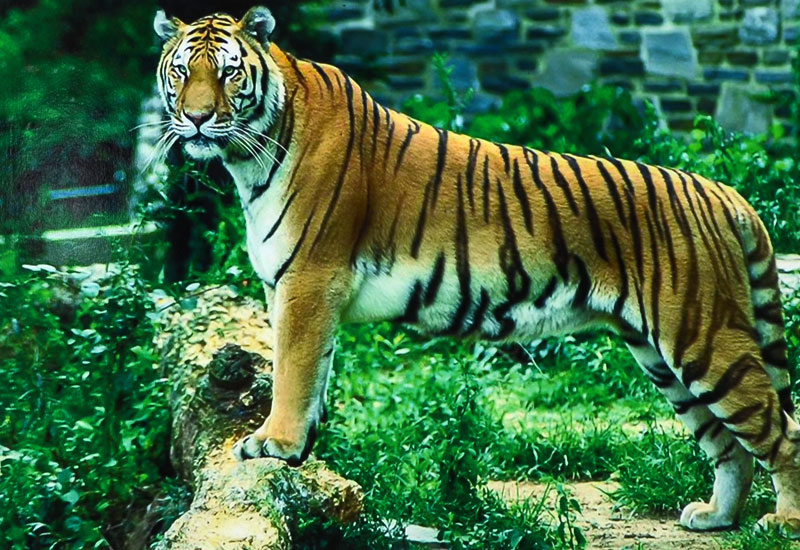
New Monkey Discovered in Myanmar: the Myanmar Snub-Nosed Monkey
Described in the American Journal of Primatology, the Myanmar snub-nosed monkey was only discovered after researchers heard reports from hunters of a strange monkey with upturned nostrils and prominent lips. It is known locally as meynwoah, or 'monkey with an upturned face'. Locals find it easy to find this species as they say it sneezes when it rains. Apparently rainwater collects on the monkey's upturned noses causing them to sneeze. To combat this, the monkeys spend rainy days with heads tucked between legs.!
National Geographic reported: Based on talks with the Lisu hunters, scientists estimate that only about 300 of these monkeys remain. The discovery of a new monkey proves just how little is known about the country's wildlife.
First Photographs of the Myanmar Snub-Nosed Monkey
In 2012, mongabay.com reported, a remote camera trap took the first ever photo of the Myanmar snub-nosed monkey. No scientist has ever seen a living individual and the monkey's life is obscured by the little-explored forests of northern Myanmar.
Protecting the Myanmar Snub-Nosed Monkey
A protected area is being established to protect the snub-nosed monkey's roaming range. This was also a recommendation by the China Power Investment Corporation, which is building a series of dams in Myanmar. In addition, conservationists are working quickly with local residents to minimize hunting and trapping and methods of providing alternative incomes.
Snakes in Myanmar
Many King Cobras, which are used by snake charmers, are found in the Mt. Popa region. The poisonous Banded Krait and other snakes are offered at restaurants in Thein Gyi market. The Chinese in Burma are particularly fond of snake, which they believe increases the male libido.
Burmese Pythons

Burmese pythons are native to Southeast Asia and can live to be 25 years old. Sometimes kept as pets, they reach lengths of 6.5m (21ft) and achieve the width of a telegraph poll. Burmese pythons are known to feed on almost any living creatures. They have been observed eating a full-grown deer and even alligators.
Burmese pythons are well camouflaged in the wild with patterns of interlocking, dark brown ‘splotches’ on a gray background. The coloration varies from area to area but the ‘arrowhead’ markings on the top of the head are always present. Females are larger than males. They usually lay 20 to 55 eggs in tree hollows or burrows in the ground. They regulate the temperature of their eggs by ‘vibrating’ their muscles to generate heat. If necessary they do this until the eggs hatch.
A full grown Burmese python feeds on mammals and birds and has no natural predators. Tigers, Leopards and Pythons tend to leave each other alone. Sometimes the Indian python and Burmese python are regarded as the same species. Large numbers of Burmese pythons have taken over the Florida Everglades in the USA. Despite this these pythons are endangered in many parts of their natural habitats in India and Southeast Asia.
Irrawaddy River Shark
The Irrawaddy river shark is a species of requiem shark known only from a single museum specimen originally caught at the mouth of the Irrawaddy River. A plain gray, thick-bodied shark with a short rounded snout, tiny eyes and broad first dorsal fin, the Irrawaddy river shark is difficult to distinguish from other members of its species without close examination. Virtually nothing is known of its natural history; it is thought to be a fish-eater with a viviparous mode of reproduction. The International Union for Conservation of Nature (IUCN) has assessed this species as critically endangered.
The Irrawaddy river shark is found in the delta of the Irrawaddy River near Yangon, Myanmar, apparently inhabiting brackish water in a large, heavily silt-laden river lined with mangrove forests. The sole Irrawaddy river shark specimen is a 60cm (24in) long immature male, suggesting an adult length of 1–3m (3–10ft). Like other river sharks, its body is robustly built with a high back that slopes down to a broadly rounded snout shorter than the mouth is wide. The eyes are minute, and the nares are small and widely spaced. The mouth contains 29 tooth rows in the upper and lower jaws, and has short furrows at the corners. The upper teeth are broad, triangular, and upright, with serrated margins, while the lower teeth at the front are more finely serrated with a pair of small cusp-lets at the base.
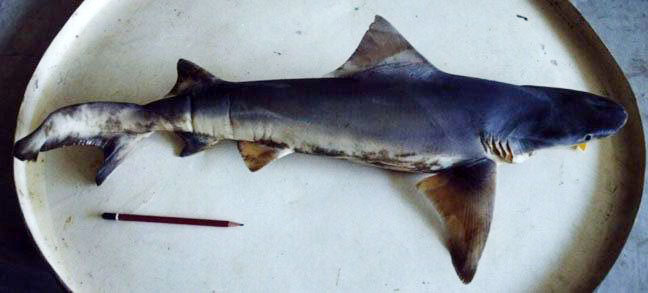
The first dorsal fin is broad and triangular, originating over the rear pectoral fin bases with its free rear tip ending in front of the pelvic fin origins. The second dorsal fin is half as tall as the first, and there is no ridge between the dorsal fins. The trailing margin of the anal fin has a deep notch.
The coloration is a plain grayish brown above and white below, without conspicuous fin markings. This shark most closely resembles the Ganges shark. The small teeth of the Irrawaddy river shark suggest that it mainly preys on fish, while its small eyes are consistent with the extremely turbid water in which it hunts. Reproduction is presumably viviparous, with the young sustained by a placental connection, as in other requiem sharks.
Intensive artisanal fishing, mainly gill-netting and electro-fishing, occurred in the stretch of river where the sole Irrawaddy river shark specimen was caught. Habitat degradation poses a further threat to this shark, including water pollution and the clearing of mangrove trees for fuel, construction materials and other products. This shark may be naturally rare, which along with its restricted range, overfishing and loss of habitat, has led the International Union for Conservation of Nature (IUCN) to list it as critically endangered.


